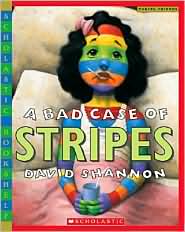"Sometimes you have to start a thing for all the wrong reasons in order to discover the right ones."
 |
| blog.schoollibraryjournal.com |
Potter, E. (2010). The kneebone boy. New York: Feiwel and Friends.
Summary
Otto, Lucia (that's Lu-chee-ah), and Max Hardscrabble are a little bit strange. Their father, Casper, is an artist who travels around the world painting portraits of fallen royalty. Their mother has gone missing, and many suspect she has died. They spend their days in Little Tunks, England mostly with each other, wishing something interesting would happen. When they are sent to stay with an aunt who is not home, they decide to go in search of a long-lost aunt-in-law, Haddie Piggit. It is then their adventure begins. Great Aunt Haddie lives in a curious seaside village in a miniature version of a mysterious old castle, called a castle folly. There they learn about the legendary creature, the Kneebone Boy, rumored to be half boy and half animal, and decide to find him. Their quest for this oddity takes them throughout the unique folly, around the grounds, and into the castle itself, where they learn important lessons about themselves and their family.
My Impressions
The narrator of this book, though a mystery to the reader, is deliciously candid, smart, and charming. One cannot help but chuckle at the narrator's observations of him- or herself, the Hardscrabble children, and the world around them. While the Hardscrabble children initially feel very much like the Baudelaire orphans of A Series of Unfortunate Events (Snicket, 1999), their identities and adventures soon become their own. While it takes a little while for the mystery to evolve, readers are encouraged at each turn of the page as they learn more about the kids and their odd, American Great Aunt Haddie. It's a little spooky, a little funny, a little bit sleepy, but very much heartwarming and worth the read.
Review
Kirkus Reviews
"The Hardscrabbles of the English town of Little
Tunks--silent Otto, the adventure-seeking Lucia and whip-smart Max--have become
accustomed to their shy, rumpled father's absences since their mother's
suspicious disappearance. ("'She's dead,' Lucia said. 'She's gone
missing,' said Max.") On one such occasion, Mr. Hardscrabble's
miscommunication with a London relative leaves the trio perilously alone in the
big city. Barely escaping the clutches of an angry tattooed man, they manage to
track down their great aunt Haddie Piggit, a youngish, eccentric American with
a penchant for Pixy Stix who lives in a child-sized version of the adjacent
Kneebone Castle in Snoring-by-the-Sea. Could she be their mother? Does Otto,
the oldest at 13, know and not say? Does the legendary, tower-bound Kneebone
Boy really have hat ears? Narrated quite personably by one of the Hardscrabbles
who refuses to be identified but is obvious, the story is fresh, funny and
surprising. The sibling dynamics--alternately testy and touching--are
believable, as are the wonderfully odd characters from the hulking taxidermist
Saint George to the ethereal Sultan of Juwi. A quirky charmer. (Fiction. 11
& up)"
[Review of the book The kneebone boy by E. Potter]. (2010). Kirkus Reviews, 78(17) 864.
Suggested Library Uses
- This book should be on any Series of Unfortunate Events read-alike list and would make a great addition to a display of comedic mysteries.
Find it @ your Library - Albany County Public Library
J Potter, Ellen





